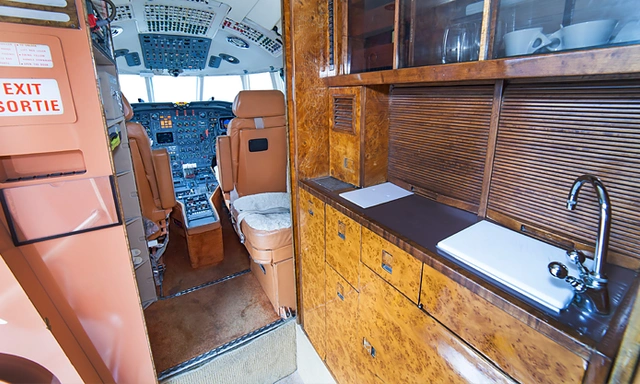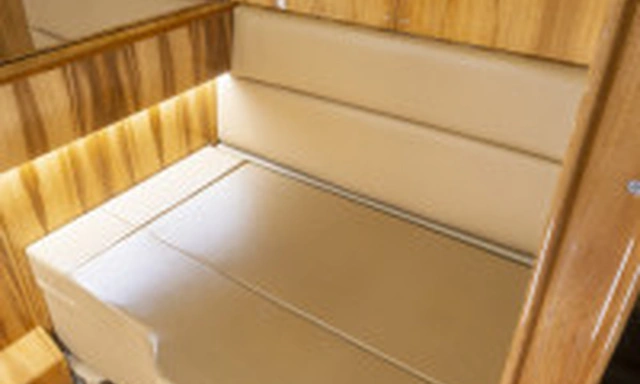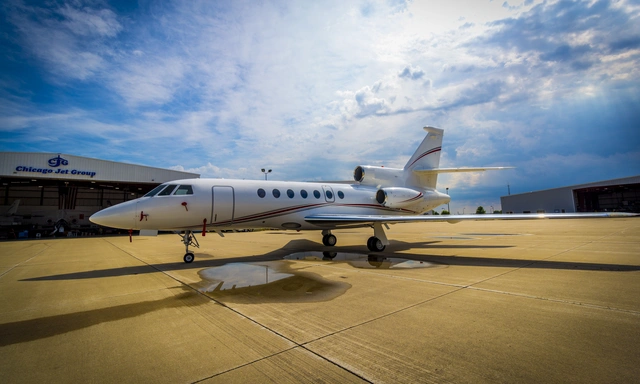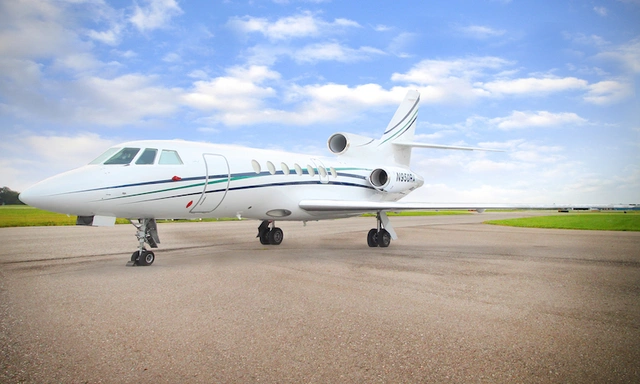Falcon 50
Dassault Aviation
| Class | Super midsize |
| ICAO | FA50 |
| IATA | DF5 |
| Max passengers | 9 |
| Typical Speed |
1574.2 km/h
850 kts
|
| Range |
5695 km
3075 nmi
|
| Cabin height | 1.8 m |
| Cabin width | 1.86 m |
| Cabin length | 7.15 m |
| Luggage volume | 2.5 m³ |
Dassault Aviation created the Falcon 50 to be able to complete intercontinental flights, and still maintain a short takeoff distance and a roomy cabin. At the time of its completion, it was the first private jet on the market with intercontinental range. Its range/payload capacity is pretty impressive, even years after its release – it can carry eight passengers 3,020 miles (2,625 nautical miles) at a speed of .80 Mach.
The cabin of the Falcon 50 is usually configured to carry eight to ten passengers. It is 5.9 feet high, 23.5 feet long, and 6.1 feet wide for a total cabin volume of 700 cubic feet. The external storage compartment is long enough to fit objects up to eight feet. The cabin of the Falcon 50 is rated to 8.7 psi, and is automatically regulated. A two-zone temperature control system uses bleed air from the center engine to control heat.
The Falcon 50 is one of the rare jets to use a three-engine configuration — in this case, three Honeywell TFE731-3-1C turbofan engines that provide 3,700 pounds of thrust each on takeoff. Each engine has a separate fuel system of about 5,000 pounds for a total fuel capacity of 15,520 pounds – enough to fly seven hours nonstop with fuel reserves.
The Falcon 50, like an increasing number of advanced midsized private jets, was designed with the help of computer-molded fluid dynamics software. Its wings are designed to minimize drag, even at high speeds. Since roughly half of the noise produced by a private jet in flight comes from the wind impacting a fast-moving structure and meeting resistance, the Falcon 50’s aerodynamic advances help keep it fairly quiet for a private jet of its size. It produces 84.3 EPNdB on takeoff, and 87 EPNdB on flyover.
Dassault strikes a good balance between range, runway performance, and speed in the Falcon 50. With a cabin measuring more than twenty-three feet long and a transcontinental range, the Falcon 50 still manages to cruise at speeds of 468 knots. Its performance levels are high while other factors, such as its takeoff distance, remain competitive.
The cabin of the Falcon 50 is usually configured to carry eight to ten passengers. It is 5.9 feet high, 23.5 feet long, and 6.1 feet wide for a total cabin volume of 700 cubic feet. The external storage compartment is long enough to fit objects up to eight feet. The cabin of the Falcon 50 is rated to 8.7 psi, and is automatically regulated. A two-zone temperature control system uses bleed air from the center engine to control heat.
The Falcon 50 is one of the rare jets to use a three-engine configuration — in this case, three Honeywell TFE731-3-1C turbofan engines that provide 3,700 pounds of thrust each on takeoff. Each engine has a separate fuel system of about 5,000 pounds for a total fuel capacity of 15,520 pounds – enough to fly seven hours nonstop with fuel reserves.
The Falcon 50, like an increasing number of advanced midsized private jets, was designed with the help of computer-molded fluid dynamics software. Its wings are designed to minimize drag, even at high speeds. Since roughly half of the noise produced by a private jet in flight comes from the wind impacting a fast-moving structure and meeting resistance, the Falcon 50’s aerodynamic advances help keep it fairly quiet for a private jet of its size. It produces 84.3 EPNdB on takeoff, and 87 EPNdB on flyover.
Dassault strikes a good balance between range, runway performance, and speed in the Falcon 50. With a cabin measuring more than twenty-three feet long and a transcontinental range, the Falcon 50 still manages to cruise at speeds of 468 knots. Its performance levels are high while other factors, such as its takeoff distance, remain competitive.
See also
Notifications
- No notifications yet
Login on another device detected!
You have reached the limit of requests!







